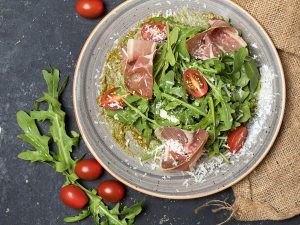The key to cooking the perfect spare ribs is in the meat. It is important to use the right cut of meat, otherwise you risk having dry, overcooked ribs. Prime cuts of pork spare ribs tend to be more expensive but they will cook up well and be tender, moist and flavorful.
Pork spare ribs are usually sold in slabs that weigh 2-3 pounds each. For best results, buy a slab that has some fat on it. Trim off any excess fat before cooking, however.
For barbecuing, prime cuts of pork are preferred but tougher meat will work well also when braised in a liquid first. If you use tougher meat for your barbecue spare ribs, you should plan on a longer cooking time. The connective tissue on the tough meat will need a longer cooking time to soften it up before it is ready to eat.
You may think it’s time to get out the grill and start barbecuing. But spare ribs are a long-term investment, and you need to plan your strategy carefully. Rubs, marinades, and sauces can be a part of that strategy, but your first decision should be what kind of meat to use.
Spare ribs are typically cut from the belly of a hog, which means they’re fatty. That fat is both a blessing and a curse. On one hand, fat is flavor; on the other hand, fat doesn’t cook evenly or quickly. If you don’t give the meat enough time to cook through to the bone, you’ll end up with chewy ribs that are underdone in some spots and overdone in others. For this reason, you should choose leaner cuts of meat for your spare ribs.
To find really lean spare ribs, head to the butcher shop and ask for St. Louis style spare ribs. Unlike baby back ribs or country style ribs, St. Louis style spare ribs won’t have too much meat or fat for their own good.
Here are the categories of meat that can be used for spare ribs.
1) Pork Spare Ribs: This is the most common type of spare rib. It’s also often called side pork. They come from the belly side of the rib cage, below the section of back ribs and above the sternum (breast bone). You can get them St. Louis Style or Baby Back Style.
St. Louis Style spare ribs are flatter, while baby back ribs have more curved bones and less meat to them.
2) Beef Spare Ribs: These are less common than pork, but more common than lamb or veal in most parts of North America. They come from the lower chest area of a steer. There is a lot of bone on these and not a lot of meat, so it takes about 3 pounds to feed one person if you’re using beef ribs for a meal.
3) Lamb Spare Ribs: These are lamb’s breastbone and attached rib meat from an animal 8 to 12 weeks old. They usually weigh around 1 pound each and are expensive compared to other types of ribs because they contain so little meat. They’re also hard to find in many places unless you order them online or get them at a specialty grocer like
Many cooks find working with meat intimidating. They are worried about the potential for bacteria and other harmful things. These concerns are not unfounded, but they can be addressed. In this blog we will go over the basics of safe food handling and preparation, as well as some delicious recipes for your next family get-together.
There’s nothing better than a big pile of spare ribs to put a smile on your face and bring the family together around the table. Spare ribs can also be a great way to show off your kitchen skills. There are so many different ways to prepare them. Today I’ll be talking about some of my favorite meat cuts and how I like to use them in my spare rib recipes.
One of the most important things about grilling up the best spare ribs is choosing the right kind of meat. If you’re making baby back ribs, you want to get a rack that has nice even layers of meat and fat, and that are a nice pink color. But what about St. Louis style spareribs? These tend to be cut from the belly, so they have a lot more fat on them, which gives them a lot of flavor.
If you ever have any questions about what kind of ribs to buy, don’t hesitate to ask your butcher! They’ll know what’s best for whatever dish you’re planning to make.
Meat is more than just a food. Meat is an experience. The right meat can transport you to another time and place. It’s so much more than simply a means of survival. When your mouth waters at the sight of a thick rare steak, you are connecting with the first human who picked up a rock and hit the first wild animal he could find over the head with it. He was hungry and in need of sustenance, but this paleolithic caveman was also experiencing something wonderful: meat!
This blog is going to be about meat, but not just about eating it. We’re going to discuss every aspect of meat: preparing it, cooking it, eating it, and enjoying it.
Meat is more than food; it’s an experience that can be enjoyed by everyone from the full-time chef to the novice home cook who is learning how to create a memorable meal for friends and family.
The leading spice in the world is pepper. Next comes salt. Then cloves, cinnamon, and nutmeg. And then, at number six, comes mace.
Mace is the spice that comes from nutmeg. It’s the red membrane that surrounds the nutmeg seed. You can see it in this picture of a whole nutmeg:
Nutmegs are native to Indonesia, but most of the world’s supply comes from Grenada, a small Caribbean country with a history shaped by its many nutmeg plantations. Mace is often used to flavor meat or fish and also goes well with vegetables like carrots and squash. But it’s most commonly used in desserts and pastries, especially doughnuts and cakes.
Mace is a common ingredient in pumpkin pie spice blend and eggnog, but it also has a peculiar use in pickled eggs, which you can make at home if you have enough patience (see this recipe).

